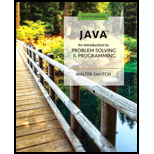
Java: An Introduction to Problem Solving and Programming (8th Edition)
8th Edition
ISBN: 9780134462035
Author: Walter Savitch
Publisher: PEARSON
expand_more
expand_more
format_list_bulleted
Textbook Question
Chapter 11, Problem 3E
Write a recursive method that will compute the number of odd digits in a number.
Expert Solution & Answer
Want to see the full answer?
Check out a sample textbook solution
Students have asked these similar questions
4. |z + 5 - 5i| = 7
14.
dz,
C: |z❘
C: |z❘ = 0.6
ze² - 2iz
H
14.
dz,
C: |z❘
C: |z❘ = 0.6
ze² - 2iz
H
Chapter 11 Solutions
Java: An Introduction to Problem Solving and Programming (8th Edition)
Ch. 11.1 - What output will be produced by the following...Ch. 11.1 - What is the output produced by the following code?Ch. 11.1 - Write a recursive definition for the following...Ch. 11.1 - What is the output of the following code? public...Ch. 11.1 - Prob. 5STQCh. 11.1 - Complete the definition of the following method....Ch. 11.2 - Revise the method getCount in Listing 11.5 so that...Ch. 11.2 - Prob. 8STQCh. 11.2 - Prob. 9STQCh. 11.2 - Suppose you want me class ArraySearcher to work...
Ch. 11.2 - What Java statement will sort the following array,...Ch. 11.2 - How would you change the class MergeSort so that...Ch. 11.2 - How would you change the class MergeSort so that...Ch. 11.2 - If a value in an array of base type int occurs...Ch. 11.3 - Convert the following event handler to use the...Ch. 11 - What output will be produced by the following...Ch. 11 - What output will be produced by the following...Ch. 11 - Write a recursive method that will compute the...Ch. 11 - Write a recursive method that will compute the sum...Ch. 11 - Complete a recursive definition of the following...Ch. 11 - Write a recursive method that will compute the sum...Ch. 11 - Write a recursive method that will find and return...Ch. 11 - Prob. 8ECh. 11 - Write a recursive method that will compute...Ch. 11 - Suppose we want to compute the amount of money in...Ch. 11 - Prob. 11ECh. 11 - Write a recursive method that will count the...Ch. 11 - Write a recursive method that will remove all the...Ch. 11 - Write a recursive method that will duplicate each...Ch. 11 - Write a recursive method that will reverse the...Ch. 11 - Write a static recursive method that returns the...Ch. 11 - Write a static recursive method that returns the...Ch. 11 - One of the most common examples of recursion is an...Ch. 11 - A common example of a recursive formula is one to...Ch. 11 - A palindrome is a string that reads the same...Ch. 11 - A geometric progression is defined as the product...Ch. 11 - The Fibonacci sequence occurs frequently in nature...Ch. 11 - Prob. 4PPCh. 11 - Once upon a time in a kingdom far away, the king...Ch. 11 - There are n people in a room, where n is an...Ch. 11 - Prob. 7PPCh. 11 - Prob. 10PPCh. 11 - Prob. 12PP
Additional Engineering Textbook Solutions
Find more solutions based on key concepts
Porter’s competitive forces model: The model is used to provide a general view about the firms, the competitors...
Management Information Systems: Managing The Digital Firm (16th Edition)
List for advantages of SQL-invoked routines.
Modern Database Management
_____ is data the computer collects from the world outside of the computer.
Starting Out With Visual Basic (8th Edition)
In the following exercises, write a program to carry out the task. The program should use variables for each of...
Introduction To Programming Using Visual Basic (11th Edition)
The Bridgeport vertical-spindle milling machine is perhaps the single most popular machine tool. Virtually ever...
Degarmo's Materials And Processes In Manufacturing
This statement causes a function to end and sends a value back to the part of the program that called the funct...
Starting Out with Python (4th Edition)
Knowledge Booster
Learn more about
Need a deep-dive on the concept behind this application? Look no further. Learn more about this topic, computer-science and related others by exploring similar questions and additional content below.Similar questions
arrow_back_ios
SEE MORE QUESTIONS
arrow_forward_ios
Recommended textbooks for you
 C++ Programming: From Problem Analysis to Program...Computer ScienceISBN:9781337102087Author:D. S. MalikPublisher:Cengage Learning
C++ Programming: From Problem Analysis to Program...Computer ScienceISBN:9781337102087Author:D. S. MalikPublisher:Cengage Learning C++ for Engineers and ScientistsComputer ScienceISBN:9781133187844Author:Bronson, Gary J.Publisher:Course Technology Ptr
C++ for Engineers and ScientistsComputer ScienceISBN:9781133187844Author:Bronson, Gary J.Publisher:Course Technology Ptr Microsoft Visual C#Computer ScienceISBN:9781337102100Author:Joyce, Farrell.Publisher:Cengage Learning,
Microsoft Visual C#Computer ScienceISBN:9781337102100Author:Joyce, Farrell.Publisher:Cengage Learning,- Programming Logic & Design ComprehensiveComputer ScienceISBN:9781337669405Author:FARRELLPublisher:Cengage
 EBK JAVA PROGRAMMINGComputer ScienceISBN:9781337671385Author:FARRELLPublisher:CENGAGE LEARNING - CONSIGNMENT
EBK JAVA PROGRAMMINGComputer ScienceISBN:9781337671385Author:FARRELLPublisher:CENGAGE LEARNING - CONSIGNMENT Systems ArchitectureComputer ScienceISBN:9781305080195Author:Stephen D. BurdPublisher:Cengage Learning
Systems ArchitectureComputer ScienceISBN:9781305080195Author:Stephen D. BurdPublisher:Cengage Learning

C++ Programming: From Problem Analysis to Program...
Computer Science
ISBN:9781337102087
Author:D. S. Malik
Publisher:Cengage Learning

C++ for Engineers and Scientists
Computer Science
ISBN:9781133187844
Author:Bronson, Gary J.
Publisher:Course Technology Ptr

Microsoft Visual C#
Computer Science
ISBN:9781337102100
Author:Joyce, Farrell.
Publisher:Cengage Learning,

Programming Logic & Design Comprehensive
Computer Science
ISBN:9781337669405
Author:FARRELL
Publisher:Cengage

EBK JAVA PROGRAMMING
Computer Science
ISBN:9781337671385
Author:FARRELL
Publisher:CENGAGE LEARNING - CONSIGNMENT

Systems Architecture
Computer Science
ISBN:9781305080195
Author:Stephen D. Burd
Publisher:Cengage Learning
Introduction to Big O Notation and Time Complexity (Data Structures & Algorithms #7); Author: CS Dojo;https://www.youtube.com/watch?v=D6xkbGLQesk;License: Standard YouTube License, CC-BY